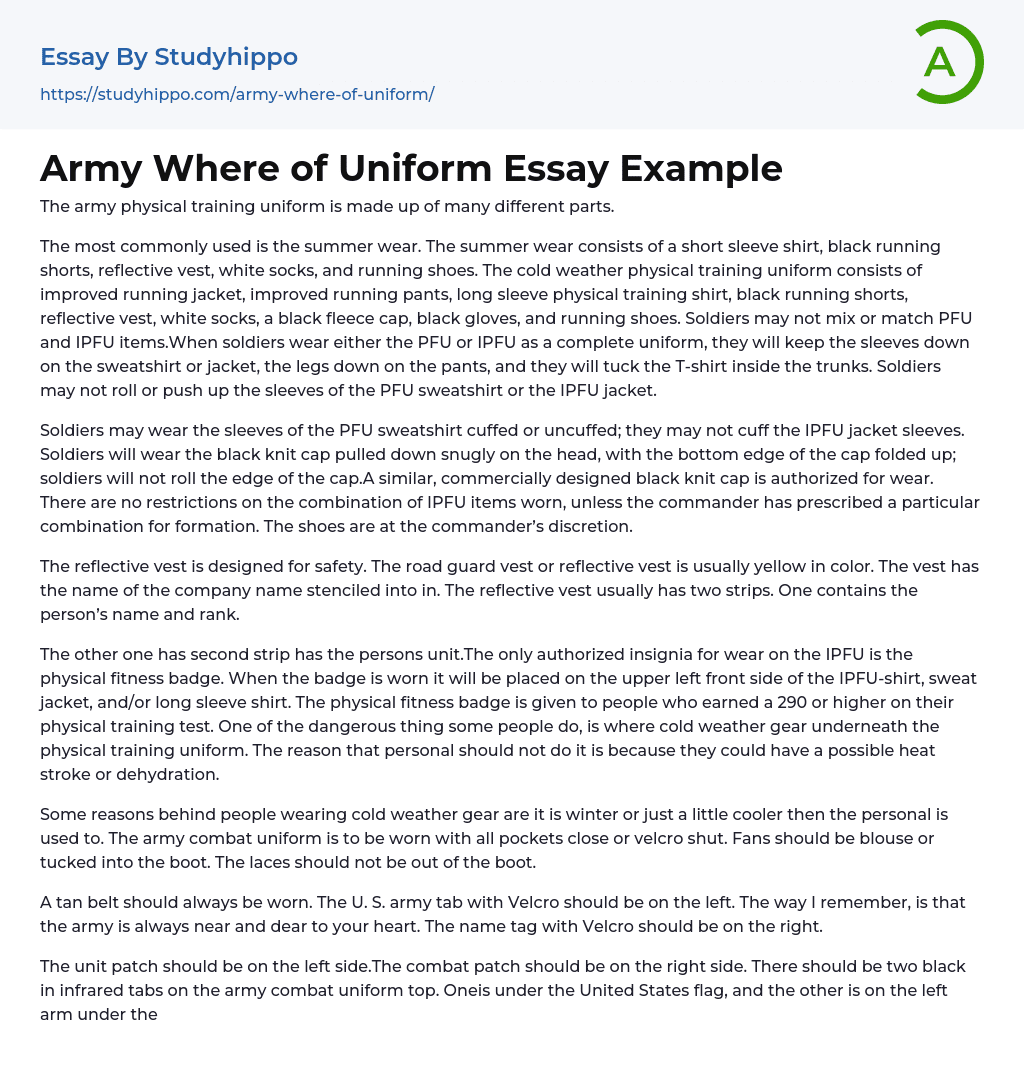The military workout outfit comprises numerous distinct components.
The most commonly used uniform is for summer wear, which includes a short sleeve shirt, black running shorts, reflective vest, white socks, and running shoes. For cold weather physical training, the uniform consists of an improved running jacket, improved running pants, long sleeve physical training shirt, black running shorts, reflective vest, white socks, a black fleece cap, black gloves, and running shoes. Soldiers are not allowed to mix or match PFU and IPFU items. When wearing either uniform as a complete outfit, soldiers must keep the sweatshirt or jacket sleeves down and the pants legs down, as well as tucking in the T-shirt inside the trunks. Rolling or pushing up the sleeves of the PFU sweatshirt or IPFU jacket is not allowed.
Soldiers have the
...option to cuff or leave uncuffed the sleeves of their PFU sweatshirt, but are prohibited from cuffing the IPFU jacket sleeves. To wear a black knit cap, soldiers must pull it down tightly over their head and fold up the bottom edge, but are not allowed to roll the edge. A commercially designed black knit cap may also be worn. There are no limitations on wearing different IPFU items together unless instructed otherwise by the commander for formation. Shoe choice is up to the commander's discretion.
The reflective vest is intended for safety and is typically colored yellow as a road guard vest. The company name is stencil-printed onto it and it commonly includes two strips, with one indicating the individual's name and rank.
The second strip on the persons unit consists of the only authorized insignia for wear on the IPFU, which
is the physical fitness badge. Whenever worn, the badge should be placed on the upper left front side of the IPFU-shirt, sweat jacket, and/or long sleeve shirt. To earn the physical fitness badge, one must achieve a score of 290 or higher on their physical training test. It's risky to wear cold weather gear beneath the physical training uniform as it could lead to heat stroke or dehydration.
Wearing cold weather attire is typically due to the season or a lower temperature than one is accustomed to. When wearing the army combat uniform, it is necessary to have all pockets securely fastened with either zippers or Velcro. The fan should be either tucked into the boot or bloused. Additionally, the laces of the boots should be properly fastened and not hanging out of the boot.
It is important to wear a tan belt at all times, with the U.S. army tab attached with Velcro on the left side, as a reminder that the army is always close to one's heart. On the right side, the name tag should be securely fastened with Velcro.
According to regulations, the army combat uniform top must have specific insignia placement. The left side should display the unit patch, while the right side should display the combat patch. Additionally, the top should have two black infrared tabs, one located under the United States flag and the other on the left arm under the green tab.
It is necessary for a soldier to wear a tucked-in tan shirt beneath their army combat uniform top. Any items carried in the cargo pockets should not protrude or affect the uniform's appearance. The army combat uniform accommodates three
writing utensils, and it is advisable to use capped pens instead of retractable ones that could result in ink leaking and staining the top. Male soldiers must maintain a clean-shaven appearance.
Male soldiers are required to maintain a clean haircut that does not touch their ear or the back of their collar and does not extend to their eyebrows. They are also prohibited from wearing earrings. Female soldiers are allowed to wear earrings that complement their uniform. When wearing a patrol cap, soldiers should make sure that the front vertical crease aligns with the center of the forehead and the nose, while the lower portion of the cap should be approximately one inch above the eyebrows (the width of two fingers).
When wearing the patrol cap, it should have a smooth silhouette where the front, rear, and top edges form an unbroken line. The bottom of the cap should be level with the ground while standing at attention, and it should not be crushed or shaped into peaks. Officers and enlisted personnel have different rank and insignia on their berets and patrol caps. For officers and warrant officers, a non-subdued grade insignia is centered on the beret flash while enlisted personnel wear their distinctive unit insignia (DUI) centered on the beret flash. In garrison environments, officers and warrant officers wear non-subdued grade insignia on their patrol caps, while in field environments they wear subdued grade insignia.
Enlisted personnel must wear subdued grade insignia on the patrol cap in both garrison and field environments. The standard headgear is the black beret, unless assigned to units that allow for the wear of a tan, green, or maroon beret. Upon completion
of advanced individual training or officer basic courses, soldiers are issued a beret as basic headgear for utility uniforms in garrison. However, the beret should not be worn in environments where they would be impractical or in the field or training environment. It is also not to be worn on deployments without commander authorization.
To wear the beret correctly, the headband must be straight across the forehead and one inch above the eyebrows while the flash is located above the left eye and the excessive material should be draped over the right ear, extending to at least the top of the ear but not going lower than the middle. To secure the ribbon knot, personnel should cut off the adjusting ribbon ends inside the edge binding at the back of the beret. The beret should perfectly fit the head shape, meaning that soldiers cannot wear hairstyles that could harm or discriminate against it.




